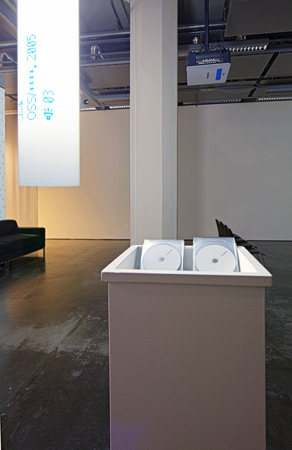|
OSS••••/****, 2005
Jodi

OSS/**** is a work on CD-ROM by the two artists Joan Heemskerk and Dirk Paesmans, known as Jodi, which consists of three programs **** ***, #Reset and %20. The version in the collection of the Espace Multimédia Gantner was made in 2005, and is an update of the original, made in 1999. The two artists who make up Jodi were among the first to be associated with net art – art made on and for the Internet. Jodi have been making work online since the 1990s, and more recently have been creating software works and modifying video games as art.
OSS/**** explores the different physical elements of a personal computer – the screen, the mouse and the keyboard – through the different programs on the CD-ROM. The interface (the computer’s standard interface) is transparent, and the user need only click directly on the programs to launch them.
**** *** exploits the functions of the mouse: the lines traced by its movements, its position each time it stops, windows that open unexpectedly; revealing fragments of text, syllabic sounds, etc. #Reset offers a variation on the screen, with grey, white and black lines scrolling at different speeds and in sequences determined by the lapse of time and by interaction with the mouse. %20 features the keyboard and its relationship with what is happening on the screen: the program takes a screen-grab of the desktop and alters it visually according to various parameters activated by the keys. The sound, and the changing, frequently stroboscopic rhythm with which the images move, create in the user a tension around the status of his or her own data, as much as a pleasurable exploration of the combinations offered by the artists.
OSS/**** was originally a CD-ROM distributed free with the Dutch magazine Mediamatic, and was then adapted by the artists to a website (http://oss.jodi.org/). The version at the Espace Multimédia Gantner has been updated because the original no longer worked when it was acquired, and was bought with the intention that it be distributed to the public as a CD-ROM, initially with the catalogue of the collection.
The work is designed to be watched on your own PC. You have to experiment with it, using your own data, in order to establish a personal relationship with the work. The artists wanted to create surprise and confusion, and to play on a certain kind of anonymity. For that reason it is not presented on a computer in the exhibition; CD-ROMS are made available to visitors.
Conservation measures
Jodi’s OSS/****has already been updated. This work, in the collection of the Espace Multimédia Gantner, was migrated in 2005 by the artists themselves, on the basis of the original version of the 1999 code. This was necessary because the original version worked only on versions of operating systems that were contemporaneous with it, and by 2005 the Mac OS9 was no longer in use. The programs had been written using Director software and were updated using a more recent version. This software is hardly used nowadays, but it was a tool for making a wide variety of works in the 1990s.
The migration that has already taken place has involved the loss (which the artists consider acceptable) of some visual elements, such as the large number of icons in the Mac OS9 version. If it were proposed to update the work again, another development environment would have to be found. Emulation would be an appropriate strategy only if software with which users could emulate the Mac OS X and/or a PC was freely available. OSS/**** depends on a specific relationship between the keyboard, the mouse and the screen, and that ergonomic relationship is central to the artists’ intentions. In their view, OSS/**** exists in the relationship between the user and his or her computer, and if the computer no longer has these three distinct components (as in the case of a mobile phone or a graphics tablet), the work can no longer be distributed.
The way the work is distributed is as important to the artists as the programs themselves, and a conservation strategy specific to OSS/**** could not work if it included only one of those two elements. Since the CD-ROM has become practically obsolete, the most appropriate way in which to distribute the work would seem to be to make the programs available online. That already applied to the URL http://oss.jodi.org, which belongs to the artists, but the Espace Multimédia Gantner acquired the CD-ROM and the right to distribute the work in that form, rather than online. The latter choice would have the advantage of making programs available to download, thus preserving the relationship with the computer and the interaction between the user and his or her computer, as well as offering them the chance to be surprised and confused.
Photo: ONUK
|



